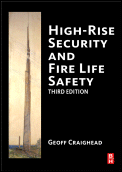Although I spent part of my career in the fire alarm industry, I was never really impressed with the types of technologies available in fire control panels. After the advent of point-addressing and remote detector diagnostics, it seemed that fire panel innovations had slowed sometime in the mid-1990s. As IP continues its march into the technologies of our industry, it was only a matter of time before fire alarm control panels would harness the power of networks for the good of both installation companies and their clients.
An excellent example of the creative use of IP horsepower in the fire alarm market is displayed by the Potter Electric Signal PFC-6800 control panel, which received a New Product Showcase award at the recent ISC West. While some of the panel’s features are stock fire alarm stuff, the capability to both report status and trouble info via the Internet along with the ability for authorized users to interrogate the panel remotely add up to a truly 21st Century fire alarm control.
Starting at 127 addressable detection points, the PFC6800 is expandable to up to 1,016 points by the addition of 127 point modules. So installation companies only have to purchase the size of panel they need for a specific installation. Smoke detectors, pull stations, water flow and duct detectors are individually point addressed.
One feature of this Potter control is the availability of heavy-duty power for sounding notification devices. The standard panel comes with a 10 Amp 24VDC power supply; additional PSN 1000 Power Booster boxes can add additional power up to 320 Amps. That’s plenty of juice to power virtually any number of fire alarm devices. The additional Power Boosters can be connected to the main control via 14-gauge cabling out to 6,500 feet, and additional Power Boosters can be daisy-chained with up to 6,500 feet between each box.
Included with the basic control are six notification circuits, with up to 3 Amps available for each. This power can be used for notification devices and/or other powered devices. Along with the six notification circuits there are four I/O circuits, which can provide up to 1 Amp of power and can be used for additional notification circuits or as separate additional inputs from non-addressed devices such as water flow switches.
A unique feature of this control is the ability to “Quadrasync” up to four different manufacturers’ horn/strobes. For those jobs where an existing fire alarm needs to be upgraded or expanded, horn/strobes from Gentex, System Sensor, Wheelock, or Potter can be synchronized so that they all light or sound simultaneously with each other. The specific types of horn/strobes must each be on their own circuit; for example, all of the horn/strobes on one notification circuit must be from the same vendor.
While all of the above makes for a modern and robust fire alarm control system, it is its use of IP technology that the PFC6800 shines. Each panel comes with an RJ-45 female socket, and can be field-programmed using a laptop or Netbook equipped with the proper software from Potter. The panel allows for the programming of up to 20 email addresses that can be used in various ways based on system and user needs. For example, a certain set of email addresses can receive system trouble signals, or scheduled system status reports which include event buffer and smoke detector sensitivity reports. Any authorized user can send an email to the panel with the word “history” in the subject line and the panel will return to that person a history report.
By using the word “configuration” in the address line the complete current programming of the panel can be remotely received by the user. So if the original technician who programmed the panel with his or her laptop isn’t available, the installing/servicing company can collect the complete programming directly from the panel. Users can receive timed reports, such as weekly status and history reports, and users can email the panel to subscribe or unsubscribe to the reports as needed. Potter provides a free email server for these controls so there is no cost to the dealer for the email service.
Along with an optional DACT, this control can deliver all of its alarm and trouble signals via connection to the Internet. This panel is UL listed for IP alarm communication when connected to a DSC Sur-Gard central station receiver.
According to Craig Summers, national sales manager for Potter, there are some issues that installing companies need to be aware of when planning to use IP alarm transmissions for fire systems. Some AHJs are requiring that all devices that connect the panel to the Internet, such as network switches, routers and adapters, must have the same backup power duration as the alarm panel itself. Summers stated that the next edition of NFPA 72, due out this fall, should further clarify this issue.
Summers indicated that AHJs sometimes interpret the NFPA 72 requirements for IP monitoring a little differently, so check with them first on issues.
Along with all of these IP-centric features, Potter Signal also provides a five-year limited warranty on all of its products.
Just as it has done for security alarm companies, IP features as seen in this control panel will help fire alarm installation companies provide faster response to system trouble conditions, reducing servicing time as the panel will provide to the installing dealer its exact status and any trouble issues. Shorter service calls equals quicker “up time” for systems, improving the protection for end users while lowering servicing costs.
Check it out at www.pottersignal.com.
Recommended Book: Ghost in the Wires |
|
The world’s most dangerous hacker details his adventures in penetrating various public networks while simultaneously spying on law enforcement agents who are trying to nab him in Ghost in the Wires by Kevin Mitnick. It’s a great and fun read, with an underlying message about the vulnerability of most network systems. It’s amazing how much trouble you can get into without actually stealing anything of value. Available at the usual literary locations, bookstores or online. |










